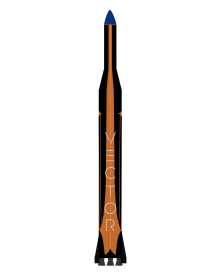 | |
| Function | Small satellite launch vehicle |
|---|---|
| Manufacturer | Vector Launch |
| Country of origin | United States |
| Cost per launch | 2–3 million USD |
| Size | |
| Height | 12 m |
| Diameter | 1.2 m |
| Mass | 5,000 kg |
| Stages | 2/3 |
| Capacity | |
| Payload to LEO | |
| Mass | 60 kg [1] |
| Payload to SSO | |
| Mass | 26 kg [2] |
| Associated rockets | |
| Family | Vector (rocket family) |
| Derivative work | Vector-H |
| Comparable | Electron, Falcon 1, Firefly Alpha |
| Launch history | |
| Status | Active |
| Launch sites | Mojave Air and Space Port Spaceport Camden Pacific Spaceport Complex – Alaska (planned) MARS Pad OB (planned) Spaceport Florida Launch Complex 46 (planned) |
| Total launches | 2 |
| Success(es) | 2 |
| Failure(s) | 0 |
| First stage | |
| Diameter | 1.2 m (3 ft 11 in) |
| Powered by | 3 X Hadley |
| Maximum thrust | 15,000 lbf (67,000 N) |
| Propellant | Kerosene / LOX |
| Second stage | |
| Diameter | .635 m (2 ft 1.0 in) |
| Powered by | 1 X LP-2 |
| Maximum thrust | 1,000 lbf (4,400 N) |
| Burn time | 433 seconds |
| Propellant | Propylene / LOX |
Vector-R (Vector Rapid) is a two-stage orbital expendable launch vehicle under development by the American aerospace company Vector Launch to cover the commercial small satellite launch segment (CubeSats).[3] Vector Launch went bankrupt in December 2019 and re-emerged in October 2020.[4] Two prototypes were launched in 2017.
The rocket completed a maiden test flight at low altitude in May 2017.[5] Vector Launch was planning the maiden orbital launch from the Pacific Spaceport Complex in Alaska in 2019,[6] but paused operation in August 2019 due to an uncertain financing situation.[7]
An upgraded version of the Vector-R, called the Vector-H (Heavy), is in development as well.
- ^ "Vector-R (Rapid)". Vector-launch.com. Retrieved 27 October 2018.
- ^ "Vector-R : Payload User's Guide" (PDF). Vector-launch.com. Archived from the original (PDF) on 27 March 2018. Retrieved 27 October 2018.
- ^ "Vector Space Systems raises funds to develop small launch vehicle - SpaceNews.com". SpaceNews.com. 2016-04-26. Retrieved 2017-03-22.
- ^ "3. 2. 1. We're baaa-ack!".
- ^ "Vector has completed the first successful flight test of its new micro rocket". 2017-05-03. Retrieved 2017-05-04.
- ^ VECTOR (22 February 2018). "This week, Vector submitted its first launch application to the @FAANews to enable orbital launching from the Pacific Spaceport Complex - Alaska, later this year". @vectorspacesys. Retrieved 2018-02-25.
- ^ "Small satellite launcher Vector pauses operations after ousting CEO". 10 August 2019.
